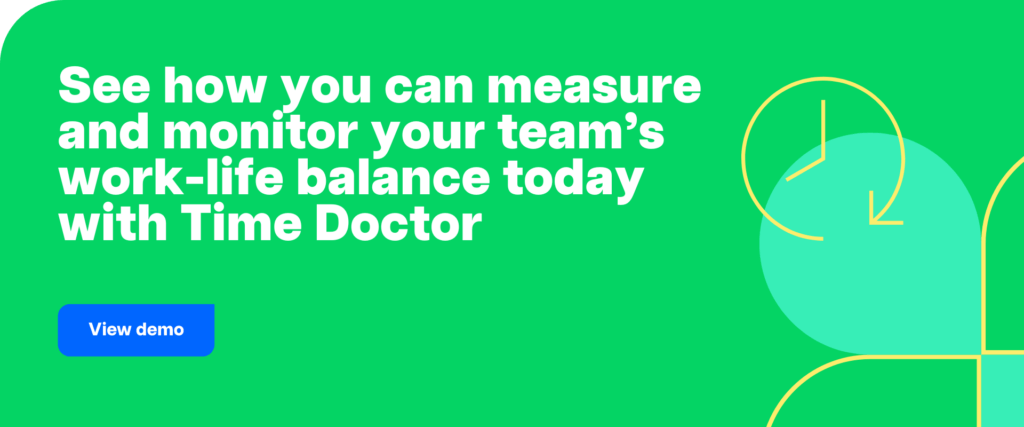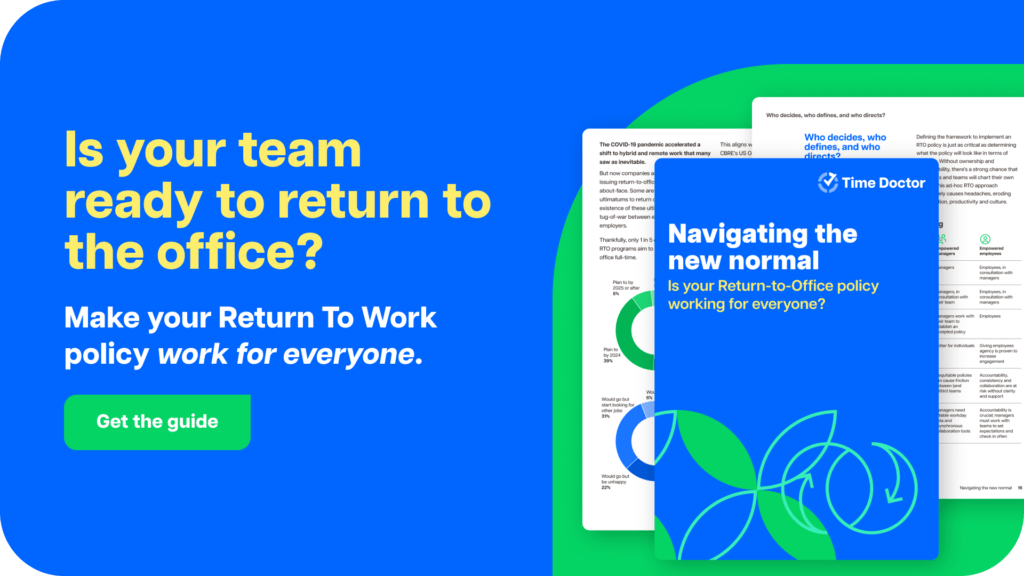A staggering 90% of companies intend to implement return-to-office policies by the end of 2024, as per an August report from Resume Builder, which surveyed 1,000 company leaders.
If you are creating a return to work plan, sending a welcoming and detailed return to work letter could make it easier for the employees and your HR (human resources) team.
It’s a document that details the timeline and the process of the return for your employees.
In this article, we’ll share how you can draft a solid return to work letter, along with three excellent tips and a free sample template you could use today.

Table of Contents
- What is a return to work letter?
- What should a return to work letter include?
- 3 best practices while drafting a return to work letter
- A return to work letter template you could use today
What is a return to work letter?
A return to work letter is a formal document that states all the necessary information for a timely return for an employee after an extended leave.
An employee could go on a leave of absence from work for many reasons, such as:
- Furlough: Temporary absence (unpaid or partially paid) from work during emergency situations such as Covid 19 pandemic or an economic crisis.
- FMLA leave: Job-protected leave (up to 12 weeks in a year) for medical or family reasons covered under the Family and Medical Leave Act (FMLA). It covers injury-related sick leave as well as maternity leave.
- Sabbatical: A break from work to pursue personal interests.
A return to work letter could be an effective way to inform the returning employee of the exact date and process of their return.
It could also be used as a quick refresher for all the things that have and haven’t changed while the employee was off work.
And at times, HR professionals use a return to work notice to gauge an employee’s intent on returning to work. It helps take timely action in case an employee chooses not to return at all or prefers to work remotely or on a part-time basis.
In any case, a well-documented return to work letter sets the expectations and makes the entire process smoother for both the employer and the returning employee.
But you should keep in mind that what goes into a return notice may vary with the nature of the leave the employee was on.
So let’s take a look at some standard information to include in a return notice.
What should a return to work letter include?
Here’s a curated list of the essential sections that should be part of the letter.
1. Specific employee details
The beginning of the return to work letter should include specific employee details such as:
- Employee’s name.
- Employee’s ID (if applicable).
- Employee’s classification like exempt vs. non-exempt or full-time vs. contractual.
- Employee’s job title.
- Employee’s department.
- Reference to employee’s leave application or furlough notice.
- Immediate supervisor/manager or a point of contact (POC).
2. A quick introduction
You may want to set a welcoming tone by quickly following up with the employee about their health or about the specific reason the employee took the break.
It’s also a good place to remind them of when their approved-time-off is coming to an end and that you expect them to return to work soon.
3. Expected date and time of joining
It’s vital to let your employee know the exact date and time that you expect them to rejoin. It eliminates any confusion and keeps your HR team and the employee on the same page.
If the employee is returning after a medical leave, being specific with the time and date will help them plan their return better.
4. Share updates
You should give the returning employees a heads-up about any changes in the company’s internal work policies since their last work tenure.
These updates may include:
- Change in the office location.
- Switch to different work modes – like from on-site to work-from-home (WFH).
- Changes in work timings.
- Changes in office dress code.
- Guidelines and protocols related to Covid 19 pandemic.
5. Revised roles and responsibilities
In this section, you should thoroughly list out the employee’s job duties and responsibilities.
It may sound redundant, but it’s important to clearly communicate what’s expected of the employee after a long gap from work. It also acts as a quick refresher and helps the employee brush up on the skills required to perform the job perfectly.
Additionally, you can highlight any changes in the employees’ duties or workflow and inform them of what new skills they’ll need to adjust to these changes.
If the employee is returning after recovering from an injury or from Coronavirus, their doctor may deem them fit for work with some physical restrictions. In such cases, you may need to modify the work plan of the injured employee and assign them suitable work until they’re fit to resume full duty.
6. Salary updates
If there have been any updates to the payroll structure in the company, you must specify the changes in the return notice.
You must clearly state the revised compensation and get the employee’s consent before rejoining.
7. Steps taken to facilitate their return
Employees may have apprehensions about coming back to work after a long absence, especially concerning the Coronavirus or their medical condition.
Moreover, if the employee is returning after recovering from a work-related injury, they might be concerned about their safety.
As an employer, you must communicate the steps you’ve taken to make the employee’s return smoother and safer.
Here are few examples of what you can include:
- Training on Covid 19 social distancing protocols as prescribed by agencies like Centers for Disease Control and Prevention (CDC).
- Safety measures related to commuting, catering, and other facilities within the office premises.
- Facilities for nursing mothers returning to work after maternity leave.
- Provisions for employees with any form of disability as specified by the OSHA.
- An introduction to your employee wellness program that prioritizes the physical and mental health of the employee.
- A toolkit to help them adjust to remote or hybrid work models.
- Links to a knowledge base and other resources to help them get quick answers to their queries.
8. Expectations from the employee
In a return to work notice, you must also list out things that you expect from the returning employee.
For example, you may need them to:
- Respond to the notice within a reasonable time period.
- Fill in a Covid 19 return to work form before rejoining.
- Present a medical document for a negative Covid 19 test result at the time of joining.
- Follow the Covid 19 guidelines and cooperate with the company’s medical provider during mandatory processes like measuring employees’ temperatures, symptoms check, office sanitization, etc.
- Submit a work release form authorized by a doctor. It should state that the employee is fit to resume job duties, with or without work restrictions.
- Provide necessary medical documentation to avail healthcare benefits such as workers’ compensation benefits.
- Present any necessary document (degree or certificate), if the employee was on an approved learning sabbatical.
- Take additional training to acquire skills necessary to meet professional expectations.
- Complete paperwork in accordance with the updated employment laws.
- Cooperate with the HR department and coworkers in getting themselves up to speed with the new work procedures.

3 best practices while drafting a return to work letter
Let’s explore three ways to make a return to work letter more welcoming and informative:
1. Use a positive and welcoming tone
When an employee returns to work, you want them to be confident and positive rather than confused and unmotivated.
That’s why the tone you use in a return to work letter plays a big role in shaping the employee’s morale.
Here are a few tips on drafting a positive and welcoming return to work letter:
- Always start by enquiring about the employee’s health and well-being.
- Thank them in advance for their patience during the transition process.
- Assure them of their safety at the workplace.
- Remind them of their strengths by pointing out their past achievements.
- Encourage them to share their fears, expectations, or any other feedback.
2. Set clear expectations
Employees may feel a little disconnected from their work environment after a long break. Reminding them of their routine work tasks, as you would do in an offer letter for a new hire, is important to set clear expectations.
Here’s a list of things you could cover in addition to their core job duties:
- Biometric authentication process.
- Tracking work hours for exempt and hourly workers.
- Remote work etiquette.
- Parking rules, etc.
- Bring your own device (BYOD) guidelines.
Now it’s not necessary to cram all the information into just one letter.
Instead, you can send a series of letters, each covering a specific topic in the time leading up to their rejoining date. Alternatively, you can attach multiple relevant documents along with your letter.
3. Communicate your initiatives
It’s important to let your employees know about the steps you’ve taken to make their return more safe and fruitful. Doing so not only instills confidence among the employees but also boosts your image as an employer.
Pro Tip: A great way to mention all your initiatives without sounding boastful is to present them as frequently asked questions (FAQs).
Now that we’ve covered the information that you should include in a return to work letter in detail, let’s check out a sample template.
A return to work letter template you could use today
Creating a return notice from scratch could take a lot of effort and time. To make things easier, here’s a sample letter template that you can edit as per your requirements:
Date
[Return to work co-ordinator]
[Company name]
[Company Address]
Re: Return to work timeline for [Employee name], [Employee id][Department name] (optional)
Dear [Employee’s name]
We hope you are doing well.
[Company name] is reaching out to remind you that your approved leave period, as specified in your leave application, is coming to an end on [date].
[Company name] is excited to welcome you back to work and strives to make the process simple and efficient.
Provided that you are medically fit to resume your job duties (please see attachment for details), we expect you to rejoin the office on [date] at [time].
[Company name] is committed to your safety and well-being. We’ve taken several initiatives to make our work environment safer and your time with us more productive and fruitful. Kindly check the attachment [title] for more information.
There have been a few changes in the company policies and procedures since your last tenure. Kindly take the time to go through these changes (please see attachment) before you consent to the return date.
Lastly, [Company name] expects you to cooperate to make your return as efficient as possible. Here’s a list of things we expect you to do:
[Add the list of required documents such as doctor’s note, training certificates, etc., as well as other expectations.]
Kindly share your concerns and feedback regarding the transition, and we’ll do our best to address them.
We request that you acknowledge this mail and respond with your consent in person, through mail or phone, latest by [date].
Sincerely,
[Return to work co-ordinator]
[Title]
[Phone number]
Disclaimer: The information in this article may not account for your local employment and healthcare laws. The author of the article and Time Doctor shall bear no legal liability that may arise from using this information.
Final thoughts
Asking your employees to return to work after a long break requires thorough planning and communication, especially in these unprecedented times.
A well-written return to work letter will help you re-align the employee with your expectations and help them adjust to the new normal at the workplace.
Use the tips and letter template in this article to draft an impressive return to work letter that makes things easier for all stakeholders.

Carlo Borja is the Content Marketing Manager of Time Doctor, a workforce analytics software for distributed teams. He is a remote work advocate, a father and a coffee junkie.


